
Separations
Scope & Guideline
Elevating Knowledge in Filtration and Separation Processes
Introduction
Aims and Scopes
- Development of Separation Techniques:
The journal covers various innovative separation techniques including liquid chromatography, gas chromatography, and solid-phase extraction, highlighting advancements that improve efficiency and effectiveness in diverse applications. - Environmental Applications:
Research focused on separation processes aimed at environmental remediation, including the removal of contaminants from water and soil, is a significant area of interest, reflecting the journal's commitment to sustainability. - Biological and Pharmaceutical Applications:
The journal features studies on the extraction and analysis of bioactive compounds from natural products, pharmaceuticals, and food matrices, contributing to advancements in drug development and nutraceutical research. - Methodological Innovations:
A consistent emphasis on methodological innovations, including the application of deep eutectic solvents, green extraction techniques, and advanced chromatographic methods, showcases the journal's role in promoting environmentally friendly practices. - Characterization and Analysis:
The journal publishes research that involves the characterization and quantification of compounds using various analytical techniques, thereby enhancing the understanding of complex mixtures and their properties.
Trending and Emerging
- Green Extraction Techniques:
There is an increasing emphasis on green extraction methods, such as the use of deep eutectic solvents and supercritical fluids, which align with global sustainability goals and environmental protection. - Advanced Chromatographic Methods:
The development of advanced chromatographic techniques, including ultra-high-performance liquid chromatography (UHPLC) and capillary electrophoresis, is trending, providing higher resolution and faster analysis times. - Integration of Machine Learning and AI:
The integration of machine learning and artificial intelligence in data analysis and optimization of separation processes is gaining popularity, reflecting the trend towards automation and precision in analytical chemistry. - Biotechnological Applications:
Emerging research focuses on biotechnological applications of separation science, particularly in the extraction of bioactive compounds from natural sources and their implications for health and nutrition. - Characterization of Complex Mixtures:
There is a growing interest in the characterization of complex mixtures from food, environmental, and biological samples, highlighting the need for sophisticated analytical techniques to understand their composition and interactions.
Declining or Waning
- Traditional Solvent Extraction Methods:
With the rise of green chemistry and sustainable practices, traditional solvent extraction methods are being overshadowed by more environmentally friendly alternatives, leading to a decline in publications focused on these techniques. - Chemical Analysis of Conventional Samples:
As the field evolves, there is a noticeable decrease in studies focused solely on conventional chemical analyses, indicating a shift towards more complex and multifaceted approaches to separation and analysis. - Studies on Low-Value Agricultural Waste:
Research specifically targeting the extraction from low-value agricultural waste has diminished, as focus shifts towards high-value applications and more economically viable sources for bioactive compounds. - Non-Targeted Screening of Environmental Contaminants:
While still relevant, the frequency of studies utilizing non-targeted screening methods for environmental contaminants appears to be waning, possibly due to the increasing complexity and cost associated with such methodologies.
Similar Journals
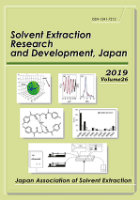
SOLVENT EXTRACTION RESEARCH AND DEVELOPMENT-JAPAN
Transforming chemical engineering with solvent extraction insights.SOLVENT EXTRACTION RESEARCH AND DEVELOPMENT-JAPAN is a prominent journal dedicated to advancing the field of solvent extraction and its applications in chemical engineering and general chemistry. Published by the Japan Association for Solvent Extraction, this journal plays a crucial role in disseminating innovative research findings, technical advancements, and comprehensive reviews pertinent to solvent extraction processes and technologies. With a publication history dating back to 1996 and extending through 2024, it serves as a vital resource for academics, industry professionals, and students alike. Although it currently does not offer open access, the journal provides invaluable insights into solvent extraction which can enhance both theoretical knowledge and practical applications in various industries. Its Scopus rankings indicate a competitive presence in the field, making it an essential read for anyone engaged in chemical engineering research. The journal is accessible via its office located at Professor Kenichi Akiba's residence at the University of Kitakyushu, and it invites contributions from researchers aiming to elevate the understanding and efficiency of solvent-based methodologies in chemical processes.

JOURNAL OF ANALYTICAL CHEMISTRY
Unveiling Breakthroughs in Instrumentation and ApplicationsJOURNAL OF ANALYTICAL CHEMISTRY, published by PLEIADES PUBLISHING INC, stands as a pivotal resource in the field of analytical chemistry, offering an innovative platform for researchers, professionals, and students to advance their knowledge and contribute to the discourse within the discipline. With an ISSN of 1061-9348 and an E-ISSN of 1608-3199, this journal features a focused exploration of analytical methodologies, instrumentation developments, and applications across various domains, contributing to practical and theoretical advancements in the field. Currently ranked in the Q3 category in Analytical Chemistry with a Scopus rank of #111 out of 156, it provides critical insights and innovation strategies for professionals aiming to enhance their analytical capabilities. Access to the journal is through standard subscription models, and it covers an extensive range of topics pertinent to the discipline from 1996 to 2024. Engage with the JOURNAL OF ANALYTICAL CHEMISTRY to be part of a vibrant research community dedicated to push the boundaries of analytical practices.

Separation Science Plus
Fostering knowledge exchange in analytical advancements.Separation Science Plus is an emerging academic journal dedicated to advancing the field of analytical chemistry and separation science. Published by WILEY-VCH Verlag GmbH, this journal provides a platform for researchers to disseminate high-quality studies and reviews that address innovative techniques and breakthroughs in separation methodologies. With its ISSN 2573-1815, the journal has made significant inroads since its inception in 2018, encompassing a convergence period until 2024. Despite currently holding a Q3 ranking in Analytical Chemistry and a Q4 ranking in Filtration and Separation, its dedication to publishing impactful research makes it a vital resource for professionals and students alike. The journal operates under the robust scholarly reputation of WILEY, which is known for its commitment to excellence in scientific communication. Researchers interested in the latest advancements in separation techniques will find Separation Science Plus an essential read, fostering the exchange of knowledge and facilitating greater understanding within this specialized field.
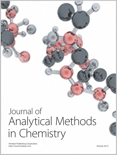
Journal of Analytical Methods in Chemistry
Pioneering research in the realm of analytical chemistry.The Journal of Analytical Methods in Chemistry, published by HINDAWI LTD, stands as a premier platform dedicated to the dissemination of research in the vibrant field of analytical chemistry. With an ISSN of 2090-8865 and an E-ISSN of 2090-8873, this Open Access journal has been committed to providing unrestricted access to quality research since 1978, thereby fostering greater collaboration and innovation among researchers, professionals, and students globally. The journal showcases rigorous research insights spanning diverse categories, earning impressive Scopus rankings including Q2 in Chemical Engineering and Q3 in Analytical Chemistry for 2023, positioning itself effectively among respected peers. Its interdisciplinary approach also covers significant contributions in the realms of instrumentation and computer science applications, thus addressing contemporary challenges and advancements in analytical methodologies. By bridging theoretical underpinnings with practical applications, the Journal of Analytical Methods in Chemistry aims to catalyze knowledge exchange while enhancing the global discourse in analytical science.
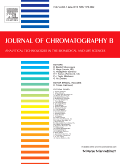
JOURNAL OF CHROMATOGRAPHY B-ANALYTICAL TECHNOLOGIES IN THE BIOMEDICAL AND LIFE SCIENCES
Catalyzing Discoveries in Chromatography and BiomedicineJOURNAL OF CHROMATOGRAPHY B-ANALYTICAL TECHNOLOGIES IN THE BIOMEDICAL AND LIFE SCIENCES, published by Elsevier, stands as a critical resource in the fields of analytical chemistry, biochemistry, and life sciences. With an impressive convergence of research spanning from 2002 to 2024, this journal delivers high-quality, peer-reviewed articles that advance the methodologies and practices related to chromatographic techniques and their applications in biomedical research. The journal enjoys a reputable standing in the academic community, reflected in its 2023 Scopus rankings—ranked in the 65th and 55th percentiles in Analytical Chemistry and Clinical Biochemistry, respectively. Although it does not offer open access, it provides a vital platform for exchanging innovative ideas and findings, guiding professionals and scholars in addressing the complexities of contemporary biomedical challenges. The journal’s focus on interdisciplinary research positions it as an essential tool for researchers, professionals, and students eager to enhance their knowledge and contribute to advancements in this dynamic field.
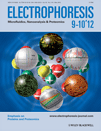
ELECTROPHORESIS
Advancing the Frontiers of Electrophoretic ScienceELECTROPHORESIS, published by Wiley, stands as a premier journal dedicated to advancing the field of analytical chemistry, biochemistry, and clinical biochemistry. With an ISSN of 0173-0835 and an E-ISSN of 1522-2683, this journal has been a vital resource since its inception in 1980 and is poised to continue its journey through to 2024. Operating out of Germany, it holds a significant standing in the academic community, featuring in the Q2 category for Analytical Chemistry and in the Q3 tier for both Biochemistry and Clinical Biochemistry as of 2023. The journal ranks impressively within Scopus, occupying the 43rd position out of 156 in Analytical Chemistry and the 44th spot out of 117 in Clinical Biochemistry, ensuring its relevance and impact in these disciplines. Although it does not currently offer open access, ELECTROPHORESIS remains an essential publication for researchers, professionals, and students seeking cutting-edge insights and developments that influence the methodologies and technologies underpinning electrophoretic techniques.
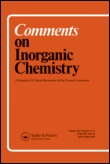
COMMENTS ON INORGANIC CHEMISTRY
Fostering Breakthroughs in Inorganic ResearchCOMMENTS ON INORGANIC CHEMISTRY is a prestigious academic journal published by Taylor & Francis Ltd, specializing in the dynamic field of inorganic chemistry. With an impressive impact factor placing it in the Q1 category, this journal ranks #6 out of 79 in its field, reflecting its high influence and contribution to the discipline, with a remarkable percentile ranking of 93rd. Since its inception in 1981 and spanning publications until 2024, this journal serves as a crucial platform for researchers, professionals, and students to disseminate groundbreaking findings, review articles, and discussions on contemporary topics in inorganic chemistry. Although it is not an Open Access journal, the rigorous peer-review process ensures the publication of high-quality research. By bridging theoretical and practical aspects of inorganic chemistry, COMMENTS ON INORGANIC CHEMISTRY remains an essential resource for advancing knowledge and fostering innovation within the scientific community.

RADIOCHEMISTRY
Fostering Collaboration in the Radiochemical CommunityRADIOCHEMISTRY, published by PLEIADES PUBLISHING INC, is a prominent journal focusing on the dynamic field of radiochemistry, encompassing both theoretical and experimental research in the application of radioactive elements and isotopes across various scientific domains. With the ISSN 1066-3622 and e-ISSN 1608-3288, this journal has been a vital resource for scholars since its inception, converging years of valuable research from 2003 to 2024. The journal currently holds a Q4 category quartile in the Physical and Theoretical Chemistry field, reflecting its niche position within this specialized discipline. Despite ranking #156 out of 189 in Scopus for Chemistry Physical and Theoretical Chemistry, with a 17th percentile ranking, RADIOCHEMISTRY continues to serve as an important forum for advancing knowledge and fostering collaboration among researchers and professionals dedicated to the study of radiochemical processes. Although it does not offer Open Access, researchers are encouraged to delve into its rich content for insights and advancements in radiochemistry.
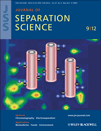
JOURNAL OF SEPARATION SCIENCE
Advancing the Frontiers of Separation ScienceJOURNAL OF SEPARATION SCIENCE, published by WILEY-V C H VERLAG GMBH in Germany, is a premier platform dedicated to the advancement of knowledge in the fields of analytical chemistry and filtration and separation technologies. With an impact factor that reflects its strong influence—ranking #42 in Analytical Chemistry and #8 in Filtration and Separation—the journal strives to disseminate high-quality research findings from both academia and industry. The journal has established a significant readership, evidenced by its Scopus rankings, and is indexed under ISSN 1615-9306 and E-ISSN 1615-9314. As part of its commitment to accessibility, the journal provides open access options, enabling broader dissemination of innovative research. Since its convergence in 2000 and continuing through 2024, JOURNAL OF SEPARATION SCIENCE has become essential for researchers, professionals, and students aiming to stay at the forefront of separation science methodologies and applications, thereby actively influencing advancements in both theoretical knowledge and practical implementations.

SEPARATION AND PURIFICATION TECHNOLOGY
Championing excellence in multidisciplinary separation studies.SEPARATION AND PURIFICATION TECHNOLOGY is a leading multidisciplinary journal published by Elsevier, focused on advancing the fields of Analytical Chemistry and Filtration and Separation. With its ISSN 1383-5866 and E-ISSN 1873-3794, this prestigious journal has achieved remarkable recognition, ranking in the top quartile (Q1) in both its categories, reflecting its substantial impact and relevance in the scientific community. Operating from its headquarters in Amsterdam, Netherlands, SEPARATION AND PURIFICATION TECHNOLOGY serves as a vital platform for researchers, professionals, and students to disseminate innovative findings and methodologies related to separation processes and purification techniques. The journal not only promotes open access research but also maintains a rigorous peer-review process to ensure high-quality publications. With a convergence period spanning from 1997 to 2025, it highlights the ongoing evolution and importance of separation technology in various applications, establishing it as an essential resource for those interested in cutting-edge advancements in analytical and chemical engineering domains.